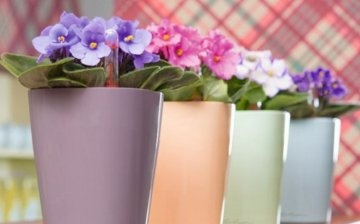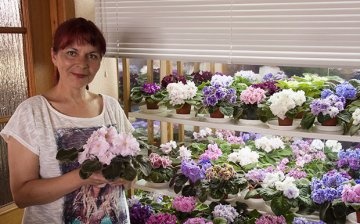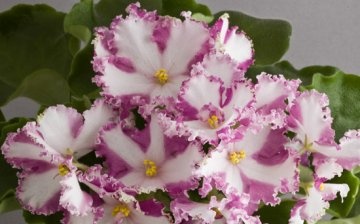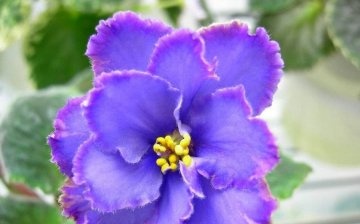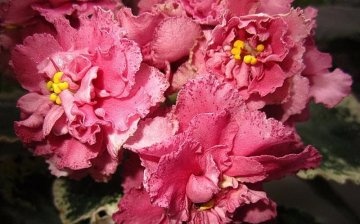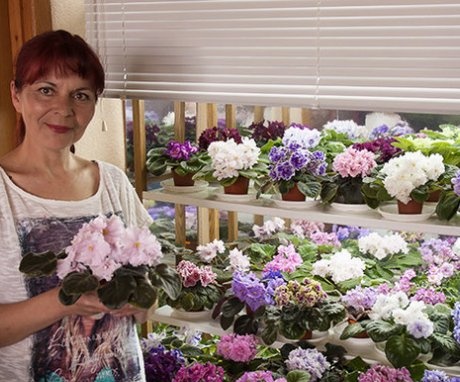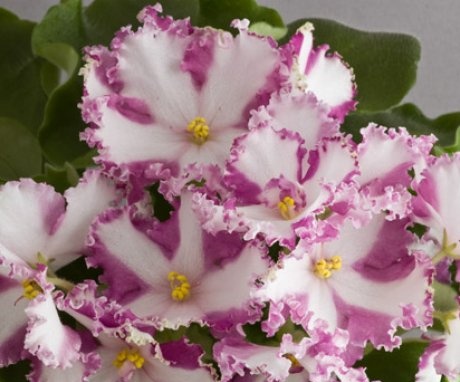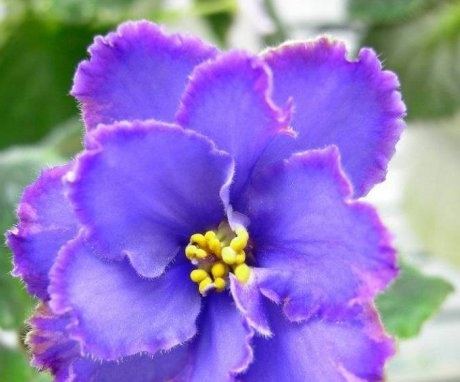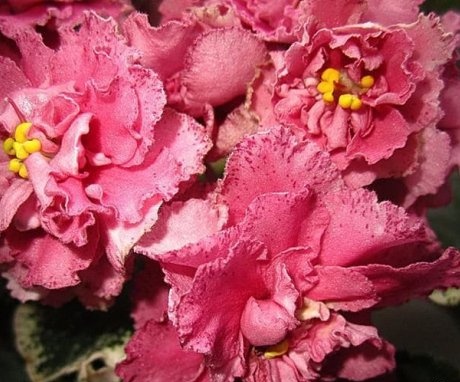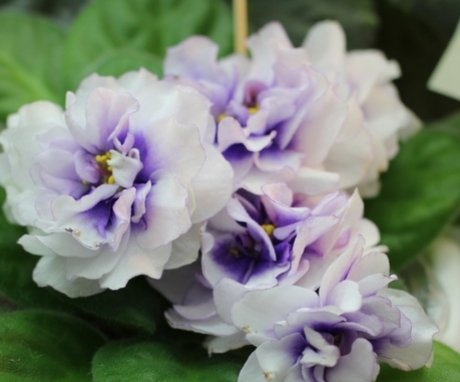New varieties of violets: a review of the best
Grow beautiful and delicate houses violets - the dream of many flower growers. This plant, which is also called saintpaulia, has a huge number of varieties and species. They differ in color and shape of buds and leaves. Many consider the violet to be a capricious plant, but caring for it is quite simple. Even the rarest and most unusual varieties of violets can be grown at home, if you follow the simple rules for their maintenance.
Content:
- Features of the choice of variety and type
- Chimera
- Winter Rose and Darling
- Blue dragon
- The land of crimson clouds
- Grizzly Ocean and Paul Bunyan
Features of the choice of variety and type
Violets have long been the favorites of many flower growers. This flower can be very varied in appearance. There are hybrid unusual varieties, the care of which does not require much effort, industrial varieties, violets-mini, collectible large species. Saintpaulia was first discovered in the mountains of Africa. And in natural conditions, the violet is distinguished by a variety of colors.
New varieties of violets continue to emerge through breeding. When choosing a particular variety, type of violet, the following nuances should be taken into account:
- If the grower is a beginner, then the choice should fall on the type that will be easier to care for. Usually these are miniature ampelous violets. Large collectible flowers will require some skill.
- If a collection of violets is planned, it is advisable to choose those species and varieties that are similar in care, so as not to waste time and effort on various watering, transplanting and creating certain conditions.
- When choosing hybrid, fantasy violets, it is necessary to clarify the features of their reproduction. Many hybrid varieties do not reproduce their traits during reproduction, that is, it will not be easy to breed such flowers.
- If the choice fell on the varieties of fantasy violets, you need to remember that their petals can change color depending on the conditions of the flower: temperature, humidity, lighting.
The violet is considered a delicate flower for a reason. She loves being cared for and taken care of. It is believed that the violet feels energy and blooms well only where love and harmony reign. Saintpaulia does not require unusual care, but it is easy to ruin it if you do not follow simple rules.
The violet will bloom magnificently and beautifully only if there is enough light for it. She loves diffused light, but not direct sunlight, which will damage the delicate petals. Like any plant, Saintpaulia loves water and needs it. Watering needs to be adjusted depending on the ambient temperature.
The violet dies both in the absence of moisture and in its excess.
It is undesirable to put a delicate violet next to large indoor flowers, palms, cacti. They often carry pests, insects that can harm Saintpaulia. But geranium will become a good neighbor for her, which usually repels insects. When planting or transplanting, it is advisable to purchase small pots, since Saintpaulia will begin to bloom only when the rhizome completely fills it.
Chimera
Unusual beautiful flowers were called chimeras violets because when they reproduce, you can get plants that are different in appearance from the mother. The Americans were actively involved in the selection of chimeras. At the moment, there are a large number of varieties of this type of violets.A feature of this flower is the fact that initially this species was not bred by breeders. Chimera is the result of a mutation.
You can distinguish a chimera from other types of violets thanks to a light strip that runs along the center of each bright petal.
Shades of buds may differ depending on the species: blue, purple, blue, crimson. Quite rarely, you can find a violet chimera, in which the stripe is present on the leaves.
This type of violet requires some care:
- Water the flower with water at room temperature or a little warmer. Chimera does not like cold water. From it, brown spots appear on the flower.
- Chimeras are small violets. When replanting them, you should not choose large pots. The diameter of the pot should not exceed 12 cm for an adult plant and 6 cm for a seedling. You can choose plastic or ceramic.
- Chimeras are quite resistant and bloom for a long time. They do not need frequent feeding. Some growers prefer not to feed the plants at all. However, if there are signs of soil depletion, you should use liquid or granular fertilizers specifically for violets.
- Chimera, like any violet, does not like when the water in the pot stagnates. To avoid waterlogging, drainage from polystyrene or expanded clay is placed on the bottom of the pot.
- There should be enough light. The Chimera is doing well on the eastern windowsill. If the lighting in the room is poor, you need to create it artificially. Without enough light, the violet will not bloom.
- It is worth remembering that the chimera is considered a capricious flower, so it will be difficult for a beginner to immediately achieve lush flowering.
At the moment, it has not been possible to purposefully obtain a chimera from a seedling. It can be formed from any other type of violet completely randomly and it is difficult to predict this process. Since it is difficult to breed a chimera, flower growers buy from specialized stores. When choosing a plant, you need to pay attention to the leaves and examine them well for spots, darkening. It is very difficult to cure a sick violet, especially for beginners.
Winter Rose and Darling
Unusual purple violet Winter rose really resembles buds rose... The flowers are very bright, deep purple with a thin white edging. This flower will become a real decoration of any flower garden. It can be multiplied without any problems. Children adopt all the features of the mother plant.
A violet with the name Darling is good because its flowering lasts a very long time. With proper care, the flower can delight the grower with bright buds almost all year round. The flowers are usually pale pink in color, but there are also lighter milky shades. The buds are not very large, medium-sized, but there are a lot of them, so Darling blooms magnificently. The color intensity depends largely on the ambient temperature. To get lighter shades, you need to put the violet in a cool place.
Caring for the Winter Rose and Darling is not much different from the standard care for Saintpaulia:
- Violet is a delicate flower that does not like drafts. Both Winter Rose and Darling will begin to ache in the draft. If it is cold air, the flower can be ruined. Therefore, it is necessary to choose those window sills where the flowers will be well protected from the movement of both cold and hot air.
- For Winter Rose and Darling, the optimum temperature will be 23-25 degrees. In the cold season, you can give the plant a rest, reducing the room temperature to 18 degrees.
- It is necessary to provide the flower with light, but protect from direct sunlight. Dear, like the Winter Rose, will report about the lack of lighting: its leaves will begin to stretch upward. If there is too much light, the leaves will start to fade.
- These violet varieties love feeding. They can be fertilized often enough, but the fertilizer should be carefully selected. The top dressing should have enough calcium, potassium, magnesium, phosphorus.Moreover, all trace elements must be balanced. In order not to be mistaken in the proportions, you can buy fertilizer in a specialized store and follow the instructions.
- It is best to water the violet at the same time. The soil should be constantly moistened, but it is necessary to avoid waterlogging and excess moisture, from which the roots of the plant can rot.
If you need to quickly propagate the plant, then it is better to choose Darling. She gives a huge number of daughter processes. They can be planted or simply removed to stimulate a more lush bloom.
Blue dragon
This amazingly beautiful flower can be found in many flower growers. The plant has large buds of a bright saturated blue color with a purple tint. The petals have a double border. It is simply impossible not to notice such a flower, so collectors often purchase it.
The Blue Dragon violet variety is considered one of the most capricious.
He does not tolerate mistakes in leaving. This hybrid variety was bred by an American breeder. Why the flower was named Blue Dragon is unknown. Perhaps due to associations with wise and generous oriental dragons.
These violets are quite large and can grow up to 45 cm in height. The buds are collected in flower stalks of 4-5 flowers. They are located slightly above the outlet, forming a kind of hat. As a rule, the size of a flower does not exceed 7 cm.
To grow this amazing flower at home and make it bloom magnificently, you need to remember some of its features:
- After the plant begins to bloom, its leaves curl a little. There is no need to change the conditions of care or to heal the plant, this is a natural process for the Blue Dragon.
- This violet can slightly change the shade of the buds. For example, at low temperatures, the light border along the edge of the bud may disappear altogether, and the entire petal may change color in the cool.
- Saintpaulias called Blue Dragon are often grown in a cool room. They grow well and bloom at low temperatures. But the capricious violet does not like high temperature. Her buds begin to shrink, and the leaves acquire a brown tint.
- You can buy land for the Blue Dragon in the store, but it's better to make it yourself. Violet does not like agrotechnical inaccuracies. To please Saintpaulia, you need to mix peat, leafy soil, fine clean sand, charcoal. The plant will like this combination.
- The Blue Dragon is very picky about lighting... Moreover, he loves the natural sunlight diffused light. It takes at least 14 hours of good and continuous lighting for a beautiful and lush bloom. In winter, when the sun sets early, artificial lighting can be used to prolong the flowering period.
For a beginner, this variety cannot be called successful. In order for the Blue Dragon to bloom beautifully and delight the eye, you need to take very careful care of it. It is worth forgetting about the rules of care a couple of times, and the flower will start to hurt. This violet is not for the lazy, it needs constant care.
The land of crimson clouds
The flower itself is as unusual as its name is. The buds of this violet are rich burgundy-crimson with a yellow core. The type of flower can be described as a double star. The leaves are large, dark green with a beautiful cream edging. By the shade of this edging, you can determine the age of the plant.
The younger the violet, the lighter the edging, but with age it acquires a pinkish tint.
The bush can have several peduncles up to 6-7 buds. They look like real bouquets. The flower multiplies easily and well, gives many daughter shoots that take on the features of the mother plant. The name of the flower is associated with the fantastic story of the Strugatsky brothers. The story describes the dangerous adventures of the crew of a starship on the planet Venus. However, the resemblance to a flower is caused precisely by color associations.
Care for this violet is standard. It is necessary to water it as needed, maintain the humidity in the room at 50%, periodically feed it with fertilizers, and provide good diffused lighting. But when transplanting or propagating this plant, you need to remember some of the nuances:
- A small violet is planted in a pot 5 cm in diameter. After a few months, the flower grows, and you have to transplant it. Do not choose a large pot right away, otherwise the plant will not bloom. It is enough to increase the diameter of the pot by a couple of cm. By all the rules, violet leaves should at least half extend beyond the edge of the pot. This size is considered optimal.
- The soil can be bought in the store or made on your own. The main requirement for it is a pH of 5.5 to 8.5. The soil should only be slightly acidic.
- You can propagate a violet called the Land of Crimson Clouds as cuttings, and daughter processes, part of the leaf. The cutting method is the simplest. It is enough to choose one leaf with a long handle and make an oblique cut so that at least 3 cm of the petiole remains. It is placed in water until it takes root, and then it is planted in prepared soil. Then a small plant is watered and covered with a film, periodically opening it so that the flower can breathe.
The land of crimson clouds is an unusual and unpretentious flower. Even beginners can buy it. It does not require complex care and multiplies easily. Such a plant will adorn any flower garden.
Grizzly Ocean and Paul Bunyan
These two unusual varieties have long won the hearts of flower growers. The violet called the Gray Ocean is famous for its fickleness. This is a chameleon flower. Initially, the flowers of this Saintpaulia have a white-purple hue, or rather, white edges and a purple core. But with each flowering of white violets on the buds it becomes less and less. The result is a completely different Violet Black Pearl. This variety also cannot be called resistant in terms of the transfer of genetic traits. The flower reproduces rather slowly.
Paul Bunyan can be called the most popular variety of violets.
It can be found both among collectors and simply among lovers of indoor flowers. This is a violet with lilac buds, which blooms for a very long time and magnificently. Terry leaves are dark green in color. The only drawback of this plant (which not everyone will think is a drawback) is that it grows very quickly. You will have to transplant the violet often.
The care of both varieties remains within the traditional violet framework. It is not required to do something unusual, but for good flowering it is necessary to provide the violet with care. You need moderate watering, an abundance of soft diffused light, an average room temperature (no more than 25 degrees), no drafts and periodic feeding.
When growing violets Gray Ocean and Paul Bunyan, you can face the following difficulties:
- Brown spots on the leaves. Such spots appear at low temperatures, for example, if the flower was watered with cold water. Violet loves water only at room temperature. If you correct this moment, the violet will quickly recover.
- The presence of a gray coating. Such a plaque on the leaves and stems indicates a fungal infection. It will be impossible to cure the flower. Infected plants are thrown away, and healthy ones are treated with drugs for prevention.
- No blooming. The violet refuses to bloom for a variety of reasons. For example, the absence of flowers indicates the wrong choice of the size of the pot, lack of lighting, fertilizers, too low room temperature.
It is worth remembering that most of the problems with violet appears as a result of improper care of her. If you adhere to the basic rules, the violet will bloom luxuriantly and give daughter shoots well.
More information can be found in the video:



